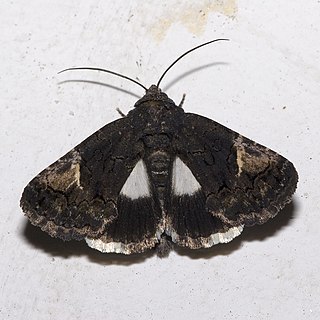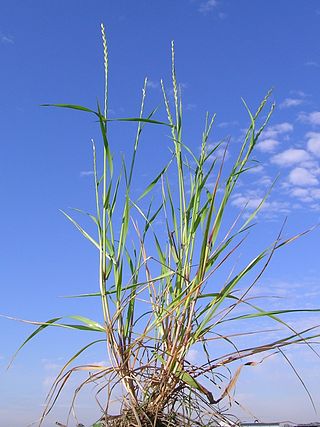
The Chamaesaura, also known as grass lizards, are a genus of legless lizards from southern and eastern Africa. The limbs are reduced to small spikes. Chamaesaura propel themselves like snakes, pushing against contact points in the environment, such as rocks, plants and irregularities in the soil. They are viviparous and eat small invertebrates, especially grasshoppers.

Trichosanthes cucumerina is a tropical or subtropical vine. Its variety T. cucumerina var. anguina raised for its strikingly long fruit. In Asia, it is eaten immature as a vegetable much like the summer squash and in Africa, the reddish pulp of mature snake gourd is used as an economical substitute for tomato. Common names for the cultivated variety include snake gourd, serpent gourd, chichindapadwal and Snake Tomato.

An ear is the grain-bearing tip part of the stem of a cereal plant, such as wheat or maize (corn). It can also refer to "a prominent lobe in some leaves."
Annual ryegrass toxicity (ARGT) is the poisoning of livestock from toxin contained in bacterially infected annual ryegrass. The toxin is produced by the bacterium Rathayibacter toxicus, which is carried into the ryegrass by the nematode Anguina funesta.
Anguina tritici is a plant pathogenic nematode.

Anguina agrostis is a plant pathogenic nematode.

Anguina is a genus of plant pathogenic nematodes.
Anguina graminis, the fescue leaf gall nematode, is a plant pathogenic nematode.
Anguina australis is a plant pathogenic nematode, who is a vector for Rathayibacter toxicus in Ehrharta longiflora.
Anguina balsamophila is a plant pathogenic nematode in mules ear.
Anguina spermophaga is a plant pathogenic nematode, that attacks sugarcane.

The Cape grass lizard, also known as the Cape snake lizard or the highland grass lizard, is a species of lizard in the genus Chamaesaura. It widely found in southern Africa, inhabiting grasslands. In one of the countries it lives in, Eswatini, it is listed as a Near Threatened species.

Aedia funesta or the druid is a moth of the family Erebidae. It is found in Central Europe, Southern Europe, Anatolia and Iran.
Zeiraphera funesta is a species of moth of the family Tortricidae. It is found in China and Russia.
Rathayibacter toxicus is a phytopathogenic bacterium known for causing annual ryegrass toxicity (ARGT) commonly found in South and Western Australia.

Lolium rigidum is a species of annual grass. Common names by which it is known include annual ryegrass, a name also given to Italian ryegrass, rigid ryegrass, stiff darnel, Swiss ryegrass and Wimmera ryegrass. It is a native of southern Europe, northern Africa, the Middle East and the Indian subcontinent and is grown as a forage crop, particularly in Australia, where it is also a serious and economically damaging crop weed.
Lacinipolia anguina, the snaky arches, is a species of cutworm or dart moth in the family Noctuidae. It is found in North America.
Corysthea is a genus of leaf beetles in the subfamily Eumolpinae. It is distributed in South America.






